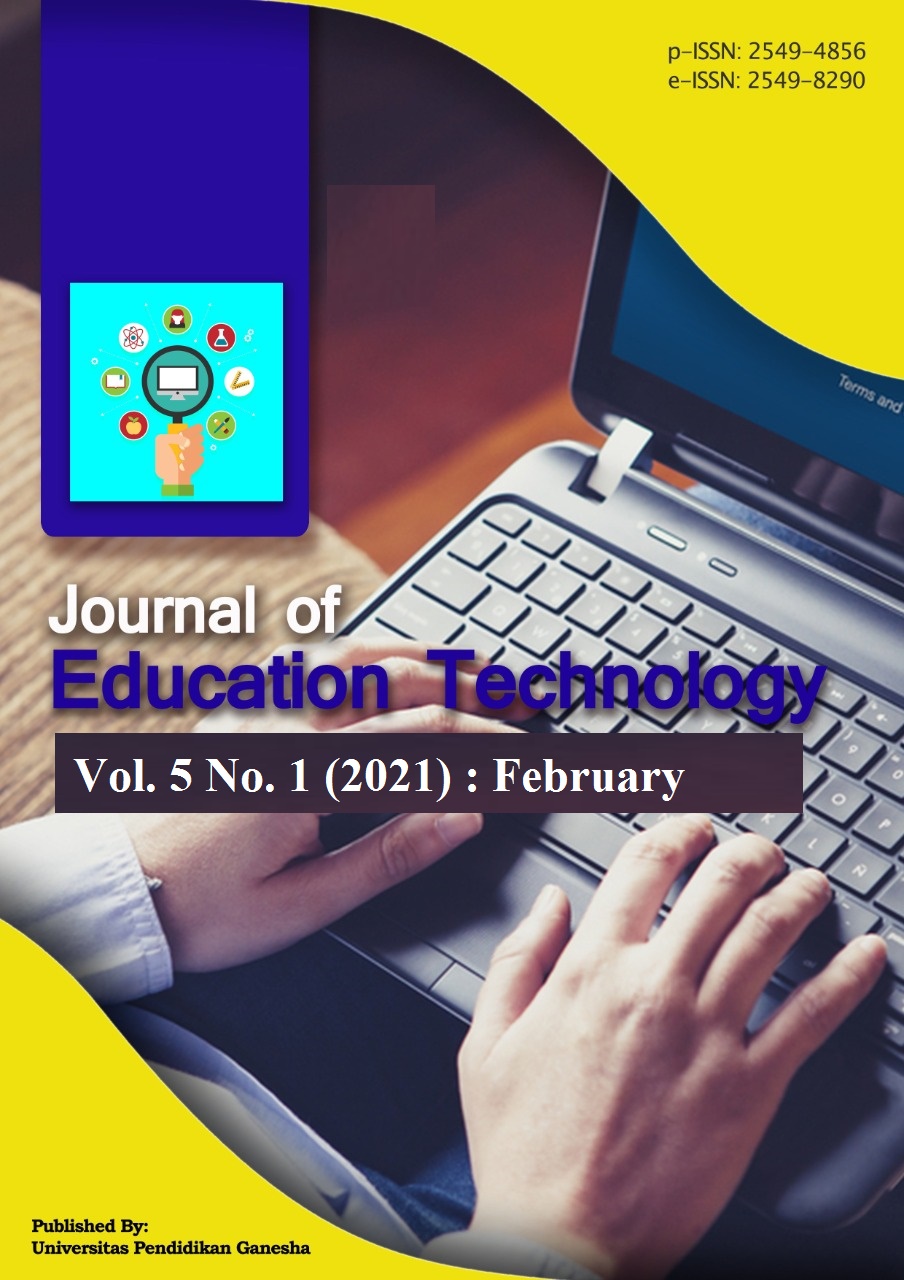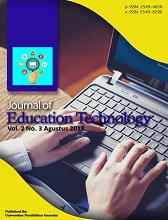Flipped Classroom for Diving Environment Training Using Cooperative Learning
DOI:
https://doi.org/10.23887/jet.v5i1.33370Kata Kunci:
flipped classroom, training, dive, cooperative learningAbstrak
Diving training at Basarnas is constrained by distance so that it has an impact on the performance of employees' duties as individuals. This study aims to develop a flipped classroom for diving environment training for rescuers and obtain results to assess their feasibility. This study produces a research design and learning development with steps and procedures, namely using a multimedia-based learning design with stages ranging from assessment and needs analysis, design, development, implementation and evaluation. The techniques used to analyze the data are qualitative and quantitative analysis. The development steps taken refer to the web-based learning design combined with the PEDATI model at the design stage. The feasibility test is obtained based on the assessment of experts including material experts, learning design experts and media experts as well as testing for users to get suggestions for improvement. From the results of this study, it was found that the evaluation of training material experts with a total percentage value of 94.79%, expert validation of learning design 90.27%, and validation by instructional media experts 90.38%. The results of the individual one-to-one test are concluded to be very valid and can be used without revision, and for tests in small groups the average assessment is very valid without revision. It can be concluded that Flipped Classroom learning is suitable for use in diving environment training using cooperative learning.Referensi
Akbar, S. (2013). Instrumen Perangkat Pembelajaran. Bandung: Rosdakarya.
Arianti. (2017). Urgensi lingkungan belajar yang kondusif dalam mendorong siswa belajar aktif. Didaktika Jurnal Kependidikan, 11(1), 41–62. https://doi.org/http://dx.doi.org/10.30863/didaktika.v11i1.161
Ceylan, A. (2017). Effect of Blended Learning to Academic Achievement. Journal of Human Sciences, 14(1), 308–320. Retrieved from https://online-journals.org/index.php/i-jet/article/view/3220
Chaeruman, U. (2017). Pedati Model Desain Sistem Pembelajaran Blended. Jakarta: Ristekdikti.
Dahniar, A. (2019). Memahami Pembentukan Sikap (Attitude) Dalam Pendidikan Dan Pelatihan. Tatar Pasundan : Jurnal Diklat Keagamaan, 13(2), 202–206. https://doi.org/10.38075/tp.v13i2.27
Damayanti, & Sutama. (2016). Efektivitas Flipped Classroom Terhadap Sikap Dan Ketrampilan Belajar Matematika Di SMK. Jurnal Managemen Pendidikan, 11(2). https://doi.org/https://doi.org/10.23917/jmp.v11i1.1799
Darmayasa, I. W. G. S., Suara, I. M., & Manuaba, I. B. S. (2013). Penerapan Model Pembelajaran Kooperatif Tipe Two Stay Two Strayberbantuan Media Gambar Untuk Meningkatkan Motivasi Dan Hasil Belajar PKn. MIMBAR PGSD Undiksha, 1(1). https://doi.org/http://dx.doi.org/10.23887/jjpgsd.v1i1.922
Dziuban, C., Graham, C. R., Moskal, P. D., Norberg, A., & Sicilia, N. (2018). Blended Learning: The New Normal and Emerging Technologies. International Journal of Educational Technology in Higher Education, 15(3), 1–16.
Elizar, & Tanjung, H. (2018). Pengaruh Pelatihan, Kompetensi, Lingkungan Kerja Terhadap Kinerja Pegawai. Maneggio: Jurnal Ilmiah Magister Manajemen, 1(1), 46–58. https://doi.org/10.30596/maneggio.v1i1.2239
Fitriana, N. (2017). Penerapan Model Pembelajaran Blended Learning Pada Mata Kuliah Pemisahan Kimia Materi Kromatografi Untuk Meningkatkan Kualitas Belajar. Journal of Educational Inovation, 4(1), 46–54. Retrieved from https://erudio.ub.ac.id/index.php/erudio/article/view/210
Foldnes, N. (2016). The flipped classroom and cooperative learning: Evidence from a randomised experiment. SAGE Journal, 17(1). https://doi.org/https://doi.org/10.1177%2F1469787415616726
Hikmawati, & Fathan. (2019). Implementasi digital assurance dalam peningkatan mutu pendidikan di sastra Inggris IAIN Surakarta. Jurnal Penjaminan Mutu, 5(1). https://doi.org/https://doi.org/10.25078/jpm.v5i1.721
Hwang, G. J., Wu, P. H., & Chen, C. C. (2012). An online game approach for improving students’ learning performance in web-based problem-solving activities. Computers and Education, 59(4), 1246–1256. https://doi.org/10.1016/j.compedu.2012.05.009
Juniantari, M., Pujawan, I. G. N., & Widhiasih, I. D. A. G. (2019). Pengaruh Pendekatan Flipped Classroom Terhadap Pemahaman Konsep Matematika Siswa SMA. Journal of Education Technology. https://doi.org/10.23887/jet.v2i4.17855
Kalantarrashidi, S. A., Mohammadpour, E., & Sahraei, F. (2015). Effect of Blended Learning Classroon Environment on Student’s Satisfaction. Journal of Educaion and Training Studies, 3(5), 225–230. https://doi.org/https://doi.org/10.11114/jets.v3i5.1013
Kurniawati, M., Santanapurba, H., & Kusumawati, E. (2019). Penerapan Blended Learning Menggunakan Model Flipped Classroom Berbantuan Google Classroom Dalam Pembelajaran Matematika SMP. Jurnal Pendidikan Matematika, 7(1), 8–19. https://doi.org/http://dx.doi.org/10.20527/edumat.v7i1.6827
Kurtz, G., Tsimerman, A., & Steiner, O. (2014). The Flipped Classroom Answer to Future Learning? European Journal of Open, Distance and E-Learning, 17(2). https://doi.org/https://doi.org/10.2478/eurodl-2014-0027
Lee, A., & Owens. (2004). Multimedia-based Instructional Design. California: Pfeiffer.
Megawati, M., & Riastini. (2014). Pengaruh Model Pembelajaran Kooperatif Tipe Inside Outside Circle (IOC) Terhadap Hasil Belajar IPA Siswa Kelas V Tahun Pelajaran 2013/2014 di Gugus VII Kecamatan Sawan. MIMBAR PGSD Universitas Pendidikan Ganesha Jurusan PGSD, 2(1). https://doi.org/http://dx.doi.org/10.23887/jjpgsd.v2i1.2450
Purnomo, Ratnawati, & Aristin. (2016). Pengembangan Pembelajaran Blended Learning Pada Generasi Z. JTP2JPS, 1(1). https://doi.org/http://dx.doi.org/10.17977/um022v1i12016p070
Raditya, & Widhiyani. (2018). Pengaruh budaya organisasi, dukungan manajemen puncak , dan pemanfaatan teknologi informasi pada kinerja sistem informasi akuntansi. E-Jurnal Akuntansi, 24(2), 845–870. https://doi.org/https://doi.org/https://doi.org/10.24843/EJA.2018.v24.i02.p02
Rochmad, R., & Ulinnuha, R. (2020). Blended learning Menggunakan Gnomio untuk Meningkatkan Kemampuan Berpikir Kreatif Matematis Siswa SMP. PRISMA, Prosiding Seminar Nasional Matematika, 3, 476–481. Retrieved from https://journal.unnes.ac.id/sju/index.php/prisma/article/view/37647
Sojayapan, & Khlaisang. (2018). The effect of a flipped classroom with online group investigation on students’ team learning ability. Kasetsart Journal of Social Sciences, 30(1). Retrieved from https://so04.tci-thaijo.org/index.php/kjss/article/view/229130
Soni, Hafid, Hayami, Fatma, Wenando, Amien, … Mukhtar. (2018). Optimalisasi Penggunaan Google Classroom, E-Learning & Blended Learning sebagai Media Pembelajaran Bagi Guru dan Siswa di SMK Negeri 1 Bangkinang. Jurnal Pengabdian Untukmu Negeri, 21. https://doi.org/https://doi.org/10.37859/jpumri.v2i1.361
Usman. (2018). Komunikasi Pendidikan Berbasis Blended Learning Dalam Membentuk Kemandirian Belajar. Jurnal Jurnalisa, 4(1), 136–150. https://doi.org/https://doi.org/10.24252/jurnalisa.v4i1.5626
Widodo, W. (2016). Wujud Kenyamanan Belajar Siswa, Pembelajaran Menyenangkan, Dan Pembelajaran Bermakna Di Sekolah Dasar. Ar-Risalah, 18(2), 22–37. Retrieved from http://ejournal.iaiibrahimy.ac.id/index.php/arrisalah/article/view/123/137
Wulandari, Sudatha, & Simamora. (2020). Pengembangan Pembelajaran Blended Pada Mata Kuliah Ahara Yoga Semester II di IHDN Denpasar. Jurnal Edutech Undiksha, 8(1), 1–15. https://doi.org/http://dx.doi.org/10.23887/jeu.v8i1.26459
Yayuk, & Sugiyono. (2019). Pengaruh kepemimpinan kepala sekolah dan biaya pendidikan terhadap kualitas proses belajar mengajar dan dampaknya dengan kompetensi lulusan SMK di kabupaten Gunungkidul. Jurnal Akuntabilitas Manajemen Pendidikan, 7(1), 84–96. https://doi.org/https://doi.org/10.21831/amp.v7i1.23758
Yusny, & Yasa. (2019). Mengembangkan (Pembelajaran) Blended Learning Dengan Sistem Lingkungan Pembelajaran Virtual (VLE) DI PTKIN. Jurnal Ilmiah Islam Futura, 19(1), 103–127. https://doi.org/10.22373/jiif.v19i1.3707
Yusuf, I., & Widyaningsih, S. W. (2018). Implementasi Pembelajaran Fisika Berbasis Laboratorium Virtual terhadap Keterampilan Proses Sains dan Persepsi Mahasiswa. Berkala Ilmiah Pendidikan Fisika, 6(1), 18. https://doi.org/10.20527/bipf.v6i1.4378
Unduhan
Diterbitkan
Cara Mengutip
Terbitan
Bagian
Lisensi
Authors who publish with the Journal of Education Technology agree to the following terms:
- Authors retain copyright and grant the journal the right of first publication with the work simultaneously licensed under a Creative Commons Attribution License (CC BY-SA 4.0) that allows others to share the work with an acknowledgment of the work's authorship and initial publication in this journal.
- Authors are able to enter into separate, additional contractual arrangements for the non-exclusive distribution of the journal's published version of the work (e.g., post it to an institutional repository or publish it in a book), with an acknowledgment of its initial publication in this journal.
- Authors are permitted and encouraged to post their work online (e.g., in institutional repositories or on their website) prior to and during the submission process, as it can lead to productive exchanges, as well as earlier and greater citation of published work. (See The Effect of Open Access)


















